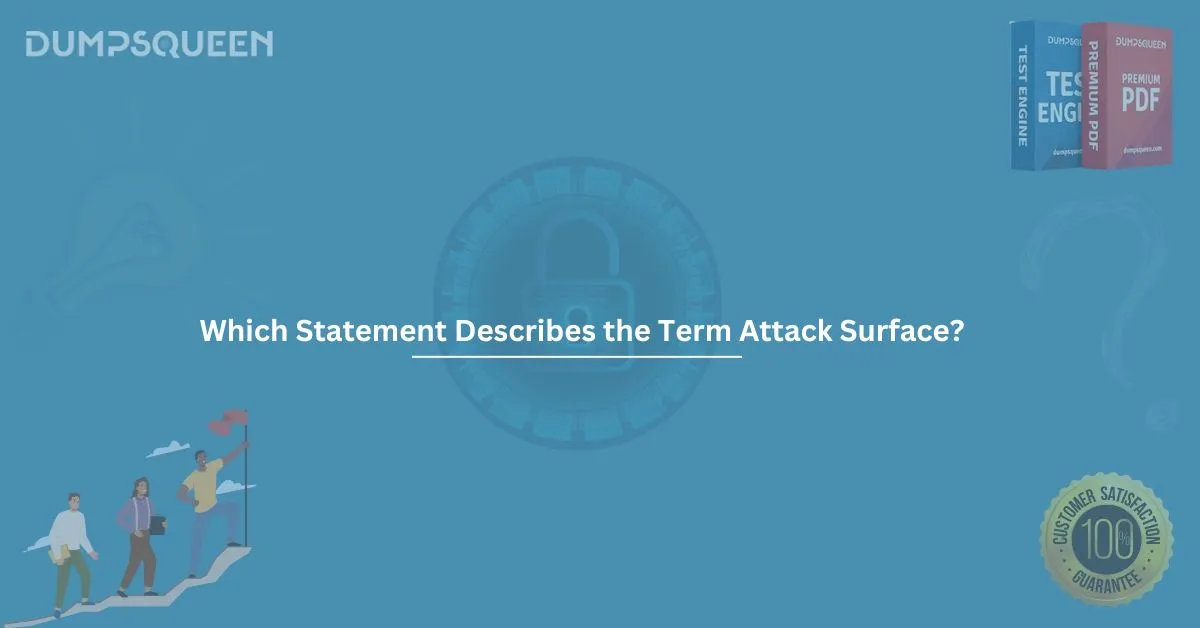In the ever-evolving world of cybersecurity, understanding technical terminologies is essential for professionals, exam candidates, and even casual learners. One of the most frequently encountered questions in security exams and interviews is:
"Which statement describes the term attack surface?"
This term holds significant importance across various cybersecurity certifications like CompTIA Security+, CEH (Certified Ethical Hacker), CISSP, and others. In this blog post by DumpsQueen Official, we’ll explore the concept of attack surface in depth, explain its relevance, types, real-world examples, and how to minimize it effectively.
Understanding the Term "Attack Surface"
Before we go into technical definitions and implications, let’s break the concept down into simpler terms.
Attack Surface refers to all the points in a system or environment where an unauthorized user (attacker) can try to enter data or extract data. It encompasses all vulnerabilities that can potentially be exploited to compromise system security.
Formal Definition
“The attack surface of a system is the sum of all the different points (attack vectors) where an unauthorized user can try to input or extract data.”
In simpler words, the larger the attack surface, the greater the number of potential vulnerabilities, and thus, a higher security risk.
Which Statement Describes the Term Attack Surface?
Here are some options you might encounter in certification exams:
A. The number of users accessing a system at any given time.
B. The total number of vulnerabilities and entry points in a system.
C. The process of patching and updating security software.
D. The configuration settings for firewalls and routers.
Correct Answer: B. The total number of vulnerabilities and entry points in a system.
Types of Attack Surfaces
Understanding the different types of attack surfaces is vital. These include:
1. Digital Attack Surface
This involves software, applications, ports, protocols, and endpoints that connect to the internet or internal networks. For example:
- Web applications
- APIs
- IoT devices
- Cloud services
2. Physical Attack Surface
Any physical device that could be tampered with by an attacker. For example:
- USB ports
- Employee laptops
- Printers and network hardware
3. Social Engineering Attack Surface
Humans are often the weakest link in cybersecurity. Attackers exploit:
- Phishing emails
- Pretexting calls
- Baiting tactics
Components of an Attack Surface
An attack surface may include several or all of the following:
- Open ports
- Outdated software
- Misconfigured servers
- Unpatched vulnerabilities
- Weak authentication mechanisms
- Public-facing APIs
- User accounts with elevated privileges
Why Is Reducing the Attack Surface Important?
1. Lower Risk of Exploits
Fewer entry points mean fewer chances for an attacker to gain unauthorized access.
2. Better Compliance
Most compliance standards (e.g., PCI-DSS, HIPAA, ISO 27001) require minimized exposure of sensitive systems.
3. Efficient Monitoring
Smaller attack surfaces are easier to monitor for anomalies and suspicious activities.
Strategies to Minimize the Attack Surface
Minimizing the attack surface involves proactive measures and strict security policies. Here’s how organizations can achieve that:
1. Disable Unused Services and Ports
If a service or port is not required, disable it to reduce exposure.
2. Apply Least Privilege Principle
Ensure that users and systems only have access to what they strictly need.
3. Patch and Update Regularly
Outdated software often becomes a gateway for attacks. Keep everything updated.
4. Implement Strong Authentication
Use multi-factor authentication (MFA) and strong password policies.
5. Conduct Regular Security Audits
Continuous monitoring helps in identifying new attack vectors.
6. Network Segmentation
Divide networks to isolate sensitive areas from public-facing components.
Real-World Examples of Attack Surface Exploitation
Example 1: Equifax Breach (2017)
A vulnerability in the Apache Struts framework—a component of their web application—was left unpatched, resulting in the breach of 147 million customer records. This was a classic example of a digital attack surface vulnerability.
Example 2: Target Data Breach (2013)
Attackers gained network access through a third-party HVAC vendor. This incident involved supply chain and social engineering attack surfaces.
Importance in Cybersecurity Exams
Whether you're preparing for CompTIA Security+, CISSP, or CEH, you will likely come across the question:
"Which statement describes the term attack surface?"
It’s a core concept in threat modeling, risk assessment, and security strategy.
Conclusion
Understanding the concept of attack surface is critical for maintaining strong cybersecurity hygiene. It is not just a term for exam preparation but a foundational element in designing secure systems. The more entry points a system has, the more vulnerable it becomes.
So the next time you encounter the question, "Which statement describes the term attack surface?", remember that it refers to the total sum of vulnerabilities and points of potential exploitation in a system.
At DumpsQueen Official, we provide accurate, reliable, and updated materials to help you prepare for security certification exams. Visit our website for trusted dumps, mock tests, and detailed explanations to boost your cybersecurity knowledge.
Sample Questions: Which Statement Describes the Term Attack Surface?
Here are a few sample questions to help you prepare better:
Q1. Which statement describes the term attack surface?
A. The size of an organization’s IT team
B. The cumulative number of vulnerabilities and entry points in a system
C. The cost associated with data breaches
D. The number of users with admin rights
Answer: B
Q2. Which of the following best represents an element of a digital attack surface?
A. Office desk layout
B. USB physical ports
C. Publicly accessible API endpoints
D. Printer paper tray
Answer: C
Q3. What is the most effective way to reduce the attack surface?
A. Increase bandwidth
B. Add more user accounts
C. Disable unnecessary services
D. Install more printers
Answer: C
Q4. A company stores customer data in a cloud-based application. Which type of attack surface is involved here?
A. Physical
B. Digital
C. Social engineering
D. None of the above
Answer: B
Limited-Time Offer: Get an Exclusive Discount on the 312-50 Exam Dumps – Order Now!




